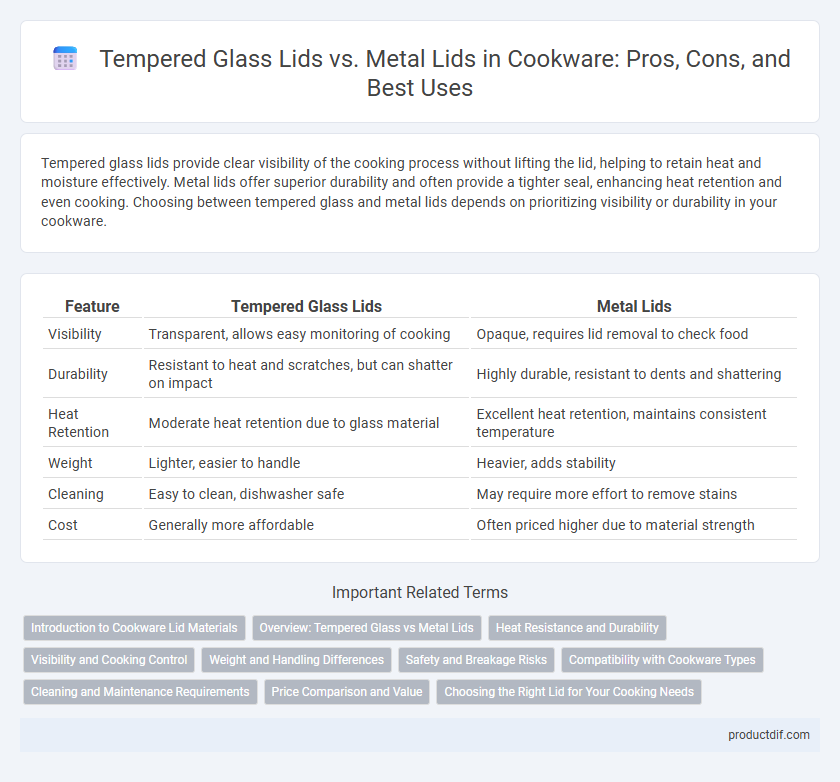Tempered glass lids provide clear visibility of the cooking process without lifting the lid, helping to retain heat and moisture effectively. Metal lids offer superior durability and often provide a tighter seal, enhancing heat retention and even cooking. Choosing between tempered glass and metal lids depends on prioritizing visibility or durability in your cookware.
Table of Comparison
| Feature | Tempered Glass Lids | Metal Lids |
|---|---|---|
| Visibility | Transparent, allows easy monitoring of cooking | Opaque, requires lid removal to check food |
| Durability | Resistant to heat and scratches, but can shatter on impact | Highly durable, resistant to dents and shattering |
| Heat Retention | Moderate heat retention due to glass material | Excellent heat retention, maintains consistent temperature |
| Weight | Lighter, easier to handle | Heavier, adds stability |
| Cleaning | Easy to clean, dishwasher safe | May require more effort to remove stains |
| Cost | Generally more affordable | Often priced higher due to material strength |
Introduction to Cookware Lid Materials
Tempered glass lids provide clear visibility of the cooking process, allowing for easy monitoring without lifting the lid and releasing heat. Metal lids, often made from stainless steel or aluminum, offer superior durability and heat retention, making them ideal for slow cooking and searing. The choice between tempered glass and metal lids depends on preferences for visibility, heat management, and lid durability in various cookware applications.
Overview: Tempered Glass vs Metal Lids
Tempered glass lids offer clear visibility during cooking, allowing users to monitor food without lifting the lid and losing heat or moisture. Metal lids provide superior durability and heat retention, often leading to faster cooking times and better sealing for simmering or braising. Choosing between tempered glass and metal lids depends on the need for visibility versus heat efficiency in cookware performance.
Heat Resistance and Durability
Tempered glass lids offer excellent heat resistance up to 400degF and allow monitoring cooking progress without lifting the lid, enhancing energy efficiency. Metal lids, typically made from stainless steel or aluminum, provide superior durability and can withstand higher temperatures above 500degF, making them ideal for high-heat cooking and oven use. Both lid types contribute to cookware longevity, but metal lids excel in resistance to warping and impact damage compared to tempered glass.
Visibility and Cooking Control
Tempered glass lids offer superior visibility, allowing cooks to monitor food without lifting the lid and losing heat or moisture. Metal lids provide tighter sealing for heat retention but obscure the cooking process, requiring frequent removal to check progress, which can affect temperature control. Choosing between tempered glass and metal lids depends on whether clear visibility or maximum heat retention is prioritized during cooking.
Weight and Handling Differences
Tempered glass lids are generally heavier than metal lids due to their thick, durable construction, providing better heat retention and allowing visual monitoring of cooking without lifting the lid. Metal lids are lighter and easier to handle, offering quick maneuverability and often featuring heat-resistant knobs for safer use. The choice between tempered glass and metal lids impacts comfort during cooking, with glass lids requiring more careful handling to avoid breakage, while metal lids prioritize lightweight convenience.
Safety and Breakage Risks
Tempered glass lids offer enhanced safety by allowing visual monitoring of cooking progress without lifting the lid, reducing the risk of splatters and burns, but they carry a breakage risk if dropped or exposed to sudden temperature changes. Metal lids provide superior durability and resistance to breakage, ensuring long-lasting performance, though they lack visibility, which might lead to more frequent lid removals and potential steam burns. Choosing between tempered glass and metal lids requires balancing the need for visual control against the risk of shattering or heat-related injuries.
Compatibility with Cookware Types
Tempered glass lids offer excellent compatibility with non-stick and stainless steel cookware, allowing users to monitor cooking progress without lifting the lid, which helps retain heat and moisture. Metal lids, often made from stainless steel or aluminum, provide superior heat conduction and durability, making them ideal for cast iron and heavy-duty pots that require high-temperature cooking. Choosing the right lid depends on the cookware material and cooking method, as tempered glass suits slower cooking techniques while metal lids excel in searing, frying, and oven use.
Cleaning and Maintenance Requirements
Tempered glass lids offer the advantage of easy cleaning due to their smooth, non-porous surface that resists stains and odors, making them dishwasher safe for convenience. Metal lids, particularly those made of stainless steel, require regular polishing to maintain their shine and prevent rust, and they may trap food residues in seams or rivets, necessitating more meticulous hand washing. Choosing tempered glass lids reduces maintenance efforts and ensures clearer visibility of cooking progress without frequent scrubbing or special cleaners.
Price Comparison and Value
Tempered glass lids generally cost more than metal lids due to their durable, heat-resistant materials and the added benefit of visibility during cooking, offering enhanced value for monitoring food without lifting the lid. Metal lids are typically less expensive and provide excellent heat retention and durability, making them a budget-friendly choice for long-term use. Consumers seeking a balance between price and functionality often find tempered glass lids justify their premium through convenience, while metal lids deliver strong value through affordability and robustness.
Choosing the Right Lid for Your Cooking Needs
Tempered glass lids provide visibility for monitoring food without lifting the lid, retaining heat and moisture efficiently, ideal for simmering and slow cooking. Metal lids offer superior durability and better heat conduction, making them suitable for high-heat cooking and searing. Selecting the right lid depends on cooking style and temperature control preferences, balancing the benefits of visibility versus heat performance.
Tempered Glass Lids vs Metal Lids Infographic

 productdif.com
productdif.com